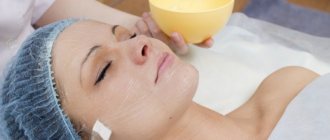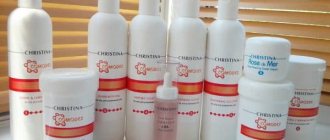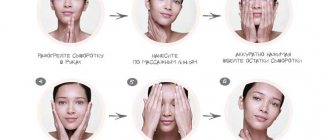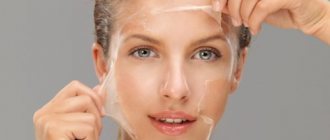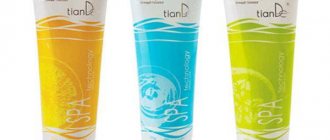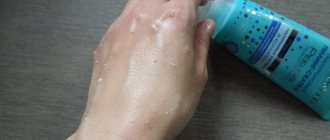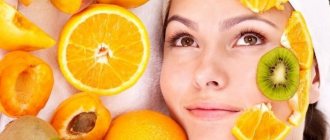It’s easy to confuse these beauty products with each other if you don’t have a special cosmetology education: after all, all the jars on the dressing table look so similar. And yet, it is necessary to know the difference between peeling and scrub, because using them incorrectly can cause significant harm to the skin.
What to choose: scrub or peeling, what is better and how does one differ from the other? Let's figure it out by refuting the most popular myths.
Misconception #3. ALL EXFOLIANTS ACT TOO WEAKLY, LIKE A SIMPLE CREAM
Exfoliants (“exfoliators”) use a much wider arsenal of methods than just a scrub (“scraper”).
We recommend: PEELING OR MESOTHERAPY: which is better?
They not only clean and degrease the epidermis, but also cope with a whole range of cosmetic problems. For example, with spider veins or subcutaneous mites.
Deep exfoliation can replace or even surpass surgical lifting. After all, it launches the natural renewal processes of collagen, elastin and hyaluronic acid.
As a result of a course of exfoliation, the composition of the skin changes qualitatively, in contrast to simply pulling the skin, like on a drum.
What is the difference between them and which is better?
Scrubbing is a cosmetic procedure that removes dead cells, dirt and oil from the face by chemical or mechanical means. Removal occurs using solid particles. They are:
- natural – crushed fruit seeds or nut shells;
- artificial - included in special creams.
Peeling is a cosmetic procedure whose purpose is to remove the stratum corneum and prevent freckles, age spots and facial contamination. Its main components are fruit acids, which weaken the connection between skin cells and promote their accelerated exfoliation.
Similarities
Peels and scrubs have almost equally aggressive effects on the skin. The former cause her a chemical burn, which can be controlled, and the latter grind the skin with particles. Due to skin injury, cell renewal occurs.
Difference between procedures
Below you can find out how these facial procedures differ:
- It is advisable to use peelings from autumn to spring, and scrubs – all year round.
- The scrub can be done at home without harm to the skin using simple ingredients: coffee, sugar, salt, honey, etc.
- Peelings have a complex composition. When preparing, be sure to take into account every gram of component.
- Scrubs work better on the surface of rough skin.
- The results from home peels are less effective than from salon peels.
- The result after scrubbing the skin is visible immediately.
- Peels must be followed in a course, then the effect will last for a long time.
- You can make a scrub both on the face and on the scalp.
- Peels can be used on the hands, neck, décolleté and face.
We recommend: What is milk peeling, what types are there and how to do it at home?
A cosmetologist will tell you briefly about the differences between scrub and peeling:
Compound
The composition of peelings and scrubs differs in that:
- the scrub consists of large solid particles and is a thick and viscous substance;
- The peeling contains tiny particles, and it itself is in the form of a liquid gel.
In addition, there are 2 main types of peelings:
- Enzymatic - enzymatic . The effect on the skin is carried out using special enzymes.
- Chemical . Their main component is various acids that activate skin cell renewal processes.
There are also 2 types of peelings:
- Hardware . It affects the skin using ultrasound, laser, high or low temperatures.
- Mechanical . Cleanses the face with abrasive elements.
The scrub contains particles that do not have such an aggressive effect on the epidermis. It may be based on:
- clay;
- gel;
- regular cream.
And abrasive elements can be:
- coffee;
- sea salt;
- grape seeds, etc.
Misconception #4. BOTH ONLY EXFOLIATE THE TOP LAYER OF SKIN
The coverings of our face are completely renewed approximately once every 30 days.
For a child, it is “soft and silky” on its own, but for an adult, additional help is needed to get rid of unnecessary dead cells.
The scrub is only superficial, and peeling also includes:
| Median | Penetrates within the layers of the epidermis to the basement membrane: a framework of collagen and elastin |
| Deep | Renews at the level of the reticular, or reticular, layer of the dermis |
Advantages and disadvantages
Peels and scrubs have many pros and cons, thanks to which you can understand whether this procedure is worth using or whether it is not suitable for you. Let's list the most basic ones.
Pros of scrubs:
- excellent against cellulite and sagging skin;
- stimulate microcirculation in cells;
- help remove excess fluid from the body;
- speed up metabolism;
- makes the skin softer, smoother and improves its color.
Minuses:
- hard particles injure the skin and lead to inflammation;
- before going out into the sun, due to recent scrubbing, you can get pigment spots;
- Constant scrubs can erase the top layer of the epidermis.
We recommend: What is mesopeeling? Features, composition and methods of use of a cosmetic product
Peeling benefits:
- improvement of complexion and structure of the face;
- cleansing and narrowing pores;
- normalization of sebum production;
- renewal of tissues and cells;
- acne treatment.
Disadvantages of the procedure:
- complications may arise due to incorrectly selected components and acids;
- the effect will be noticeable only after several procedures or even a complex;
- partial dark spots may appear on light skin;
- light pigmentation is possible on dark skin;
- After the procedures, prolonged redness of the face is possible.
Misconception #5. EXFOLIANTS CANNOT RENEW THE AREA AROUND THE EYES
Using a scrub around the eyes is, of course, contraindicated: it will injure and stretch the delicate tissues of the periorbital area.
But some types of exfoliation, for example, milk-glycolic, can also achieve an effect for the delicate eyelid area. They reduce expression lines, dark circles under the eyes, and fight dryness and pigmentation.
It is worth remembering: the procedure also has its contraindications. Nursing mothers, as well as patients with high fever or herpes, should refrain from exfoliating the eyelids.
Methods of application
The peeling procedure consists of three main stages:
- Preparation . Before applying the peeling product, clean your face with a cotton pad soaked in micellar water or makeup remover. Then wash your face using gel or foam.
- Application process . Apply the peeling composition to dry skin and leave for 5-10 minutes. Next, rinse with plain water.
- The final stage . Apply toner and moisturizer to clean, dry skin.
We recommend: What is superficial peeling and how is it done? Features of the procedure
It is better to use peeling in a course, the number of times depends on what result you want to get and where exactly you perform the procedure - at home or in the salon.
Scrubbing is also divided into several stages:
- Skin cleansing . It is necessary to cleanse your face with foam or makeup remover.
- Warming up . Using a cotton pad, napkin or towel, as well as boiling water, you need to steam your face before the procedure. This will open the pores and allow the scrub elements to penetrate deeper.
- Application . Using gentle massage movements, apply the scrub to the face and rub for 3 minutes.
- Excerpt . Then it is left for 5-10 minutes. This way, the active substances can saturate the epidermis with beneficial properties.
- Removal . The scrub is washed off with warm water.
- Completion . Apply the moisturizer you usually use.
Reference ! To get a noticeable effect, use the scrub in the evening.
Misconception #6. THE PRODUCTS DIFFER ONLY IN CONSISTENCY
Most often, women's portals state: peeling differs from scrub only in a “softer gel consistency.” The difference is found only in the absence of coarse particles of apricot kernels, crushed deer antlers and other wounding substances.
This interpretation is not entirely correct:
- HARDNESS IS DIFFERENT FOR ALL EXFOLIANTS , depending on the area of application: for the body or face;
- EXFOLIANTS CAN BE OF DIFFERENT CONSISTENS + generally DRY (brush, washcloth, mittens or socks) + LASER (when dead particles of the epidermis are pushed to the surface due to heating by a laser beam), etc.
We recommend: WHEN TO DO PEELING, and when it’s not the season
What is better - peeling or scrub?
Quite a popular question: which is better – peeling or scrub? But the answer is quite simple.
As girls who often use the substances note, peeling is better. This is because the skin will not be scratched. But without the use of the substance, it will be difficult to deeply cleanse the epidermis.
This is why you should use a scrub first. It will eliminate the shortcomings of dense top layers. And then switch to comprehensive skin care. Peeling is used for this.
The differences between the drugs are obvious, but this is not a bad thing - they complement each other, providing comprehensive care.
COMMENT BY A COSMETOLOGIST
Elena Kudashkina, Ch. doctor at the Euromedica clinic (Nizhny Novgorod)
“Both cosmetics are designed to exfoliate. Moreover, one implies mechanical abrasion with soft granules - from the point of view of microscopy, balls - which only slightly refresh the face. The other acts evenly and purposefully on an entire layer of skin, penetrating, depending on the intensity of the procedure, to a certain depth, and sometimes reaching the germ layer of cells.”
In your opinion, what is the main difference between a peeling and a scrub for the face or body?
What are the contraindications?
Facial scrub and peeling should not be used thoughtlessly. Before use, be sure to read the composition information. Otherwise, you can harm yourself.
The substances have a number of contraindications. Don't ignore them.
- If a woman has a very sensitive epidermis and is also prone to allergies, then it is prohibited to carry out any cleansing procedures. Before using medications, find out the causes of allergies. After this, you can select funds. They should be perfect for the skin.
- Do not use cleansers around the eyes. If it gets on the mucous membrane of the eye, problems may arise. In addition, the skin around the eyes is very delicate. She does not tolerate such procedures well.
- It is also not recommended to use cleansers if the skin is sick. First you need to carry out a full treatment, and only then scrub. Also, avoid using the substance if you have herpes on your skin.
- If you have a cold, you should wait for complete recovery. Before using medications, get rid of all possible problems.
- People with cardiovascular insufficiency should refrain from using cleansing substances.
- Substances for deep cleaning are prohibited in the case of kidney and liver diseases.
- It is not recommended to use deep cleansing products for people who have very sensitive and thin skin prone to rosacea. Instead, it is better to use a peeling cream, which has a more gentle effect. The composition includes nutrients and emollients that will also help moisturize the skin.
Important! Before applying substances to your skin, carefully read the instructions for use. Study the composition in full. This way you can determine the compatibility of the component with your skin type.
Both substances exfoliate old skin well. But it is recommended to do this in the absence of contraindications.
What results should you expect when using facial scrub and peeling?
Scrub – superficial cleansing of the skin. Peeling is more in-depth, focused on its rejuvenation and elimination of age spots, freckles and scars. Fading skin with slow regenerative and metabolic processes needs these procedures.
With age, the skin loses the ability to independently remove excess keratinized scales, which give it a gray, tired appearance. But as soon as you free her from this burden, she begins to breathe oxygen, absorb nutrients, and her appearance becomes much fresher.
For young girls, peelings are a good preventative against fine wrinkles ; they will smooth the surface, cleanse pores, protect against acne, and support dry and problematic skin. In addition to acids, biological stimulants, vitamins, bleaches and moisturizers are added to peelings. These supplements eliminate complications caused by the procedure.
Regular use of peeling will protect the skin from the appearance of premature wrinkles, improve complexion, smooth and increase its turgor, eliminate acne marks and pigmentation. Knowing the difference between a scrub and a facial peel, everyone will be able to independently choose what procedure their skin needs , as well as determine the frequency of its use.
What is the difference between a scrub and a facial peeling, see this video:
Peeling and scrub - the difference will be explained in this video:
